
Thanks to five key changes, the Every Student Succeeds Act (ESSA) helps ensure all students have the resources and support they need regardless of ZIP code. Here's why we're excited about the law:
1. ESSA is about opportunity.
ESSA introduces Opportunity Indicators of school success or student support to help communities identify opportunity gaps, and begin to close them.
2. ESSA reclaims teaching time from standardized testing.
ESSA has the potential to lessen the focus on standardized testing so students have more time to learn, and teachers have more time to teach. ESSA requires annual tests in grades 3-8 and once in high school. That said, the law eliminates No Child Left Behind’s (NCLB) rigid system of Adequate Yearly Progress (AYP). ESSA also allows districts to apply to use other nationally recognized assessments instead of the state standardized tests for high schools.
3. ESSA empowers educators.
Educators have a greater voice in educational and instructional decisions. Collaboration among educators, families and communities in support of local schools is incentivized.
4. ESSA is about the big picture.
State-designed accountability systems must include at least one indicator of school success or student support to ensure that states report on opportunity gaps and take action to close them. This could include access to advanced coursework, school climate and safety free from bullying, fine arts, regular physical education, and counselors or nurses.
5. ESSA protects and supports our most vulnerable students.
New provisions incentivize supports and interventions, including early childhood education and full service community schools programs, tailored to local needs. ESSA also preserves the historic role the federal government plays in protecting the most vulnerable: children of poverty, students with disabilities, and English-language learners.
The Pathway to Educator Voice
Are you an affiliate?

